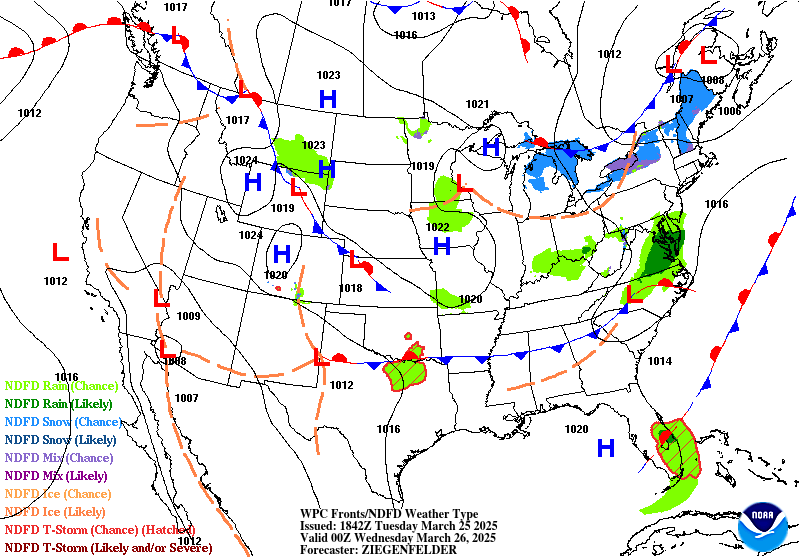The forecasts depicted below combine WPC forecasts of fronts, isobars and high/low pressure centers with the NDFD depiction of expected weather type for days .5 to 2.5 ahead. Each frame represents 6 hours. A short range forecast discussion for the CONUS is available below the short term loop.
Short Term Forecast Frontal Systems and Isobars Loop

Short Range Forecast Discussion
FXUS01 KWBC 020725 PMDSPD Short Range Forecast Discussion NWS Weather Prediction Center College Park MD 224 AM EST Fri Jan 02 2026 Valid 12Z Fri Jan 02 2026 - 12Z Sun Jan 04 2026 ...A return to a wet weather pattern for the West Coast to begin 2026... ...Much above average temperatures stretch from the Interior West to the Plains and South while below average temperatures continue from the Midwest to the Northeast... ...Active lake effect snows continue downwind of Lakes Ontario and Erie... After a brief break, a slow moving upper-trough approaching the West Coast will help to funnel Pacific moisture towards California bringing yet another Atmospheric River event heading into the weekend. Rainfall will begin to increase today (Friday) especially for areas along the coastal ranges of northern California and the northern Sierra and then spread southward into southern California Saturday. An isolated risk for flash flooding will exist today with Slight Risks of Excessive Rainfall (level 2/4) along the ranges north of Los Angeles and upslope areas of the northern Sierra on Saturday when more scattered instances of flash flooding are possible. Heavier snow will also begin for the Sierra and higher mountains in the north of the state Saturday as the upper-trough moves eastward bringing moisture further inland and cooler air to bring snow levels down. Gusty winds and some coastal flooding can be expected as well. While not quite as heavy as further south, moderate rains will also spread northward into the Pacific Northwest with snow for the higher elevations of the Cascades into Saturday. Active lake effect snows continue for portions of the Great Lakes, particularly downwind of Lakes Ontario and Erie, as very cold, westerly flow remains over the lakes. Several more inches of snow is forecast, locally more than a foot east of Lake Ontario. Elsewhere, a quick moving upper-wave and accompanying low pressure/frontal system will bring showers and thunderstorms to portions of the interior Southeast by later Friday and shift towards the East and Gulf Coasts into Saturday. Moderate to locally heavy snows will continue for some of the mountain ranges of the northern/central Rockies and Great Basin as an upper-wave passes over the region today before tapering off into the evening. Snowfall is expected to pick back up for portions of the northern Rockies as the upper-trough from the west approaches later Saturday. Well above average conditions will continue over the Interior West and expand northward over the Plains as an upper-ridge shifts eastward the next couple days. The system passing through the Southeast will also help to keep a cold front leading much chillier air to the north with above average highs expected here as well. Forecast highs generally range from the 40s and 50s for the Interior West; the 50s and 60s for the High Plains, central Plains, and Southeast; and 70s and 80s for Texas and along the Gulf Coast. Some record highs well into the 80s are possible across eastern Texas Friday. Meanwhile, conditions remain much colder and below average to the north across portions of the Midwest and into the Northeast following a cold front passage and as upper-troughing remains entrenched over the region. Highs will generally be in the teens and 20s for the Great Lakes and New England with 30s and 40s from the Middle Mississippi Valley east through the Ohio Valley and into the Mid-Atlantic. Highs will generally be around average for the West Coast, mainly in the 50s and 60s. Putnam Graphics available at https://www.wpc.ncep.noaa.gov/basicwx/basicwx_ndfd.php $$
Depicted Weather Types
- NDFD Rain (Chance) – There is chance of measurable rain (≥0.01″) at the valid time.
- NDFD Rain (Likely) – Measurable rain (≥0.01″) is likely at the valid time.
- NDFD Snow (Chance) – There is chance of measurable snowfall (≥0.01″ liquid equivalent) at the valid time.
- NDFD Snow (Likely) – Measurable snow (≥0.01″ liquid equivalent) is likely at the valid time.
- NDFD Mix (Chance) – There is a chance of measurable mixed precipitation (≥0.01″ liquid equivalent) at the valid time. “Mixed” can refer to precipitation where a combination of rain and snow, rain and sleet, or snow and sleet are forecast.
- NDFD Mix (Likely) – Measurable mixed precipitation (≥0.01″ liquid equivalent) is likely at the valid time. “Mixed” can refer to precipitation where a combination of rain and snow, rain and sleet, or snow and sleet are forecast.
- NDFD Ice (Chance) – There is a chance of measurable sleet and/or freezing rain (≥0.01″ liquid equivalent) at the valid time.
- NDFD Ice (Likely) – Measurable sleet and/or freezing rain (≥0.01″ liquid equivalent) is likely at the valid time.
- NDFD T-Storm (Chance) – There is a chance of thunderstorms at the valid time. Areas are displayed with diagonal hatching enclosed in a dark red border.
- NDFD T-Storm (Likely and/or Severe) – Thunderstorms are likely and/or the potential exists for some storms to reach severe levels at the valid time.

